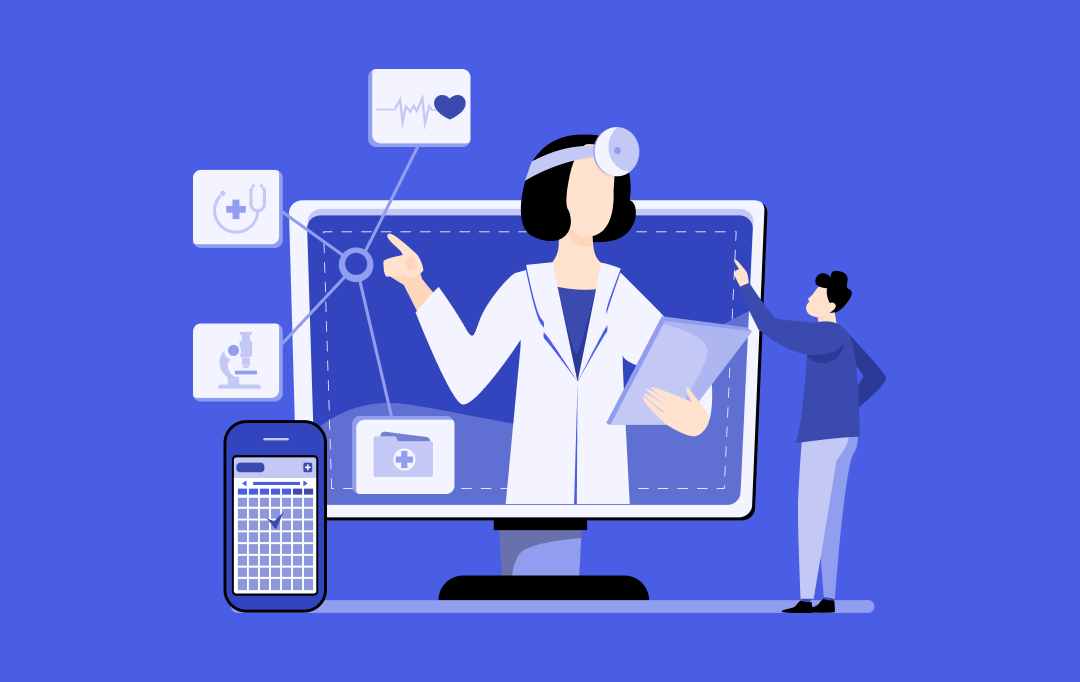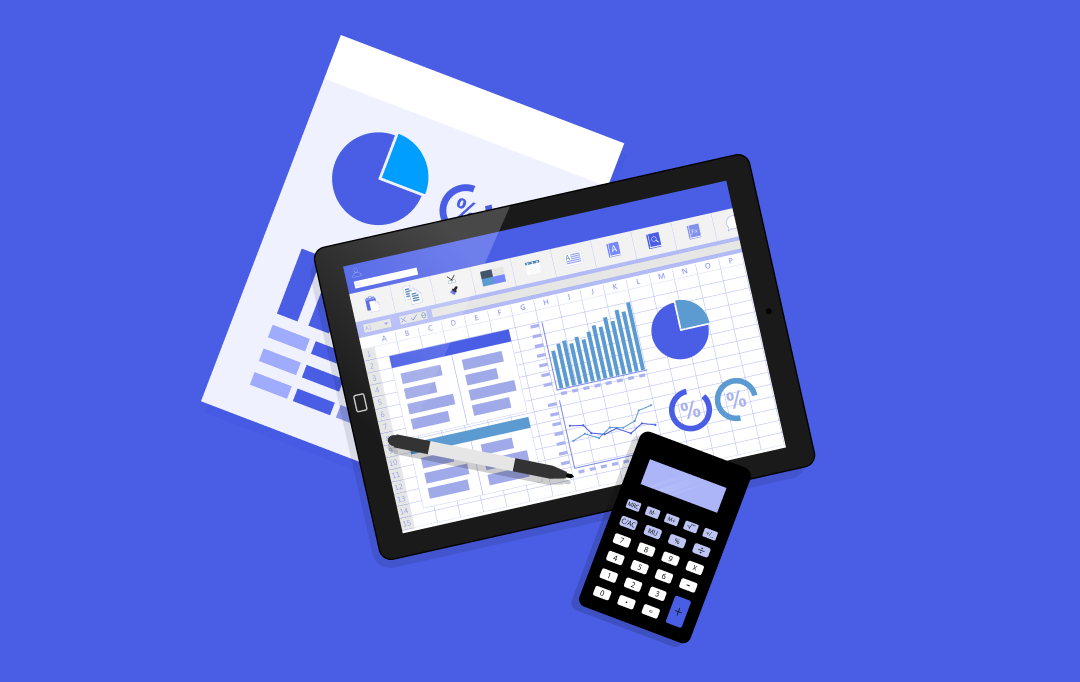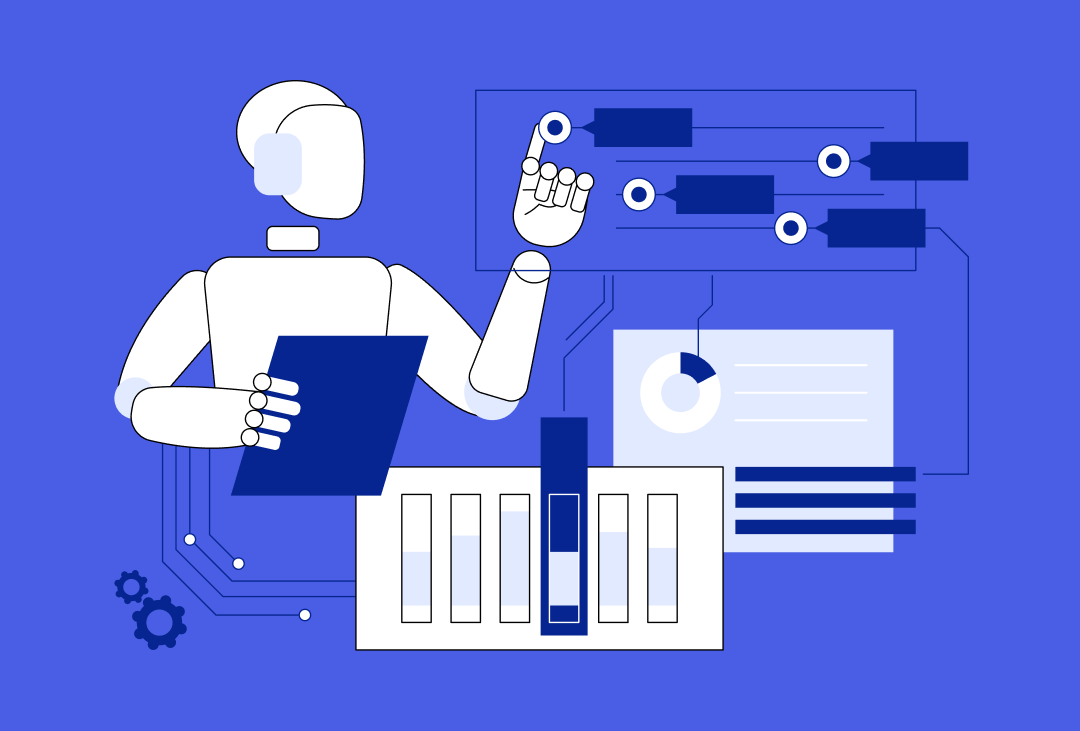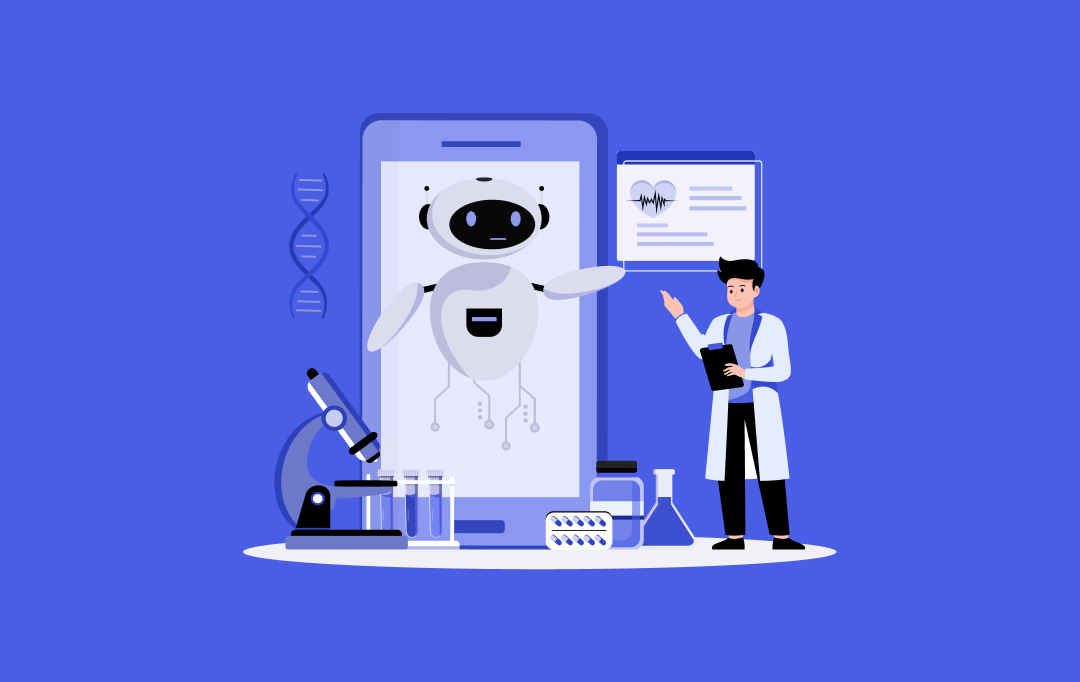Imagine a dental practice where efficiency meets precision and operational workflows are optimized like never before. That’s the game-changing impact of AI in dentistry. From automating patient diagnostics to streamlining appointment scheduling and inventory management, AI for dentistry solutions empowers dental practitioners to deliver faster, more accurate care while maximizing profitability.
Practices that leverage AI technologies can reduce overhead, enhance patient retention, and stay competitive in a rapidly evolving industry. Embracing AI in dentistry isn’t just an upgrade—it’s a strategic investment in the future of your business.
According to Markets and Markets, the global AI in healthcare market was valued at $20.9 billion in 2024 and is expected to reach $148.4 billion by 2029, with a compound annual growth rate (CAGR) of 48.1% during the forecast period. These statistics demonstrate the rapid growth of AI in healthcare, including its transformative potential in areas such as leveraging AI in dentistry.
Curious about the valuable aspects of leveraging AI in dentistry and other key areas? Let’s explore.
Benefits of AI in Dentistry: Revolutionizing Dental Care
Here are some prominent benefits of AI in dentistry: AI improves diagnostic accuracy by analyzing dental images and automates administrative tasks like appointment scheduling. It also enhances patient care through personalized treatment plans based on data analysis. Let’s understand these benefits of AI dentistry in detail.
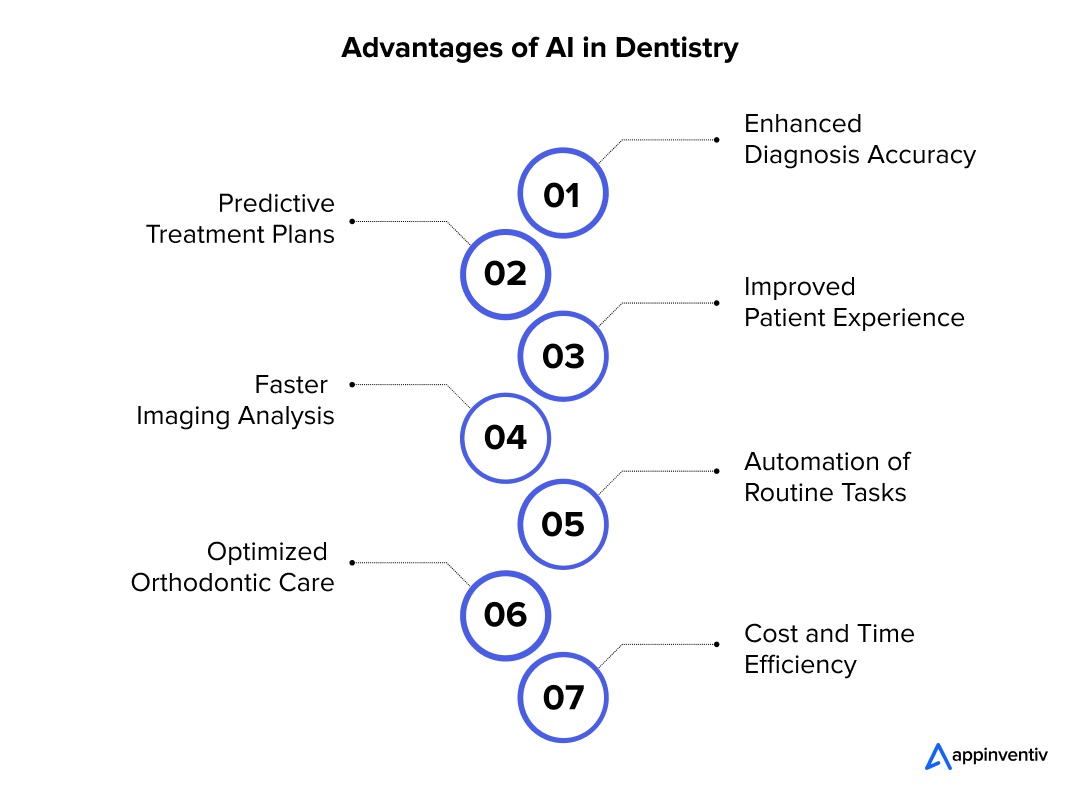
Enhanced Diagnosis Accuracy
AI-powered tools like machine learning algorithms can analyze dental images (X-rays, CT scans, intraoral photos) with incredible precision. These tools can identify early signs of cavities, gum disease, oral cancers, and other abnormalities the human eye may miss.
For example, AI in dentistry systems trained on vast datasets can more consistently differentiate between normal and abnormal structures. This improved diagnostic accuracy leads to early detection, allowing more effective and timely interventions.
Predictive Treatment Plans
AI systems can analyze patient data, including past dental records, imaging, and genetic information, to predict the progression of oral health conditions. By identifying patterns in the data, AI dental apps can help dentists develop personalized, predictive treatment plans.
For instance, AI could foresee the likelihood of tooth decay worsening or assess how a patient’s orthodontic treatment might evolve. This ability to predict future conditions enables proactive care, reducing the possibility of complications and improving long-term outcomes.
Improved Patient Experience
AI-driven virtual assistants and chatbots can handle routine patient inquiries, such as answering questions about dental procedures, providing aftercare instructions, or scheduling appointments. These systems can engage with patients in real-time, making the process more convenient and reducing the burden on clinic staff. Patients receive immediate responses, which enhances their overall experience and fosters better communication between the dentist and the patient.
Additionally, Virtual and Augmented Reality technologies enhance the experience by allowing patients to visualize procedures and better understand treatment plans, creating a more immersive and reassuring communication channel between dentists and patients.
Faster Imaging Analysis
AI dental app systems can process and interpret dental images significantly faster than traditional methods. By leveraging deep learning algorithms, AI dentistry can analyze radiographs, panoramic X-rays, or 3D scans in seconds. This reduces dentists’ time reviewing and interpreting the images, enabling them to focus more on patient care and decision-making.
Faster imaging analysis also means that diagnoses and treatment plans can be delivered promptly, often during the same visit, improving the efficiency of dental care.
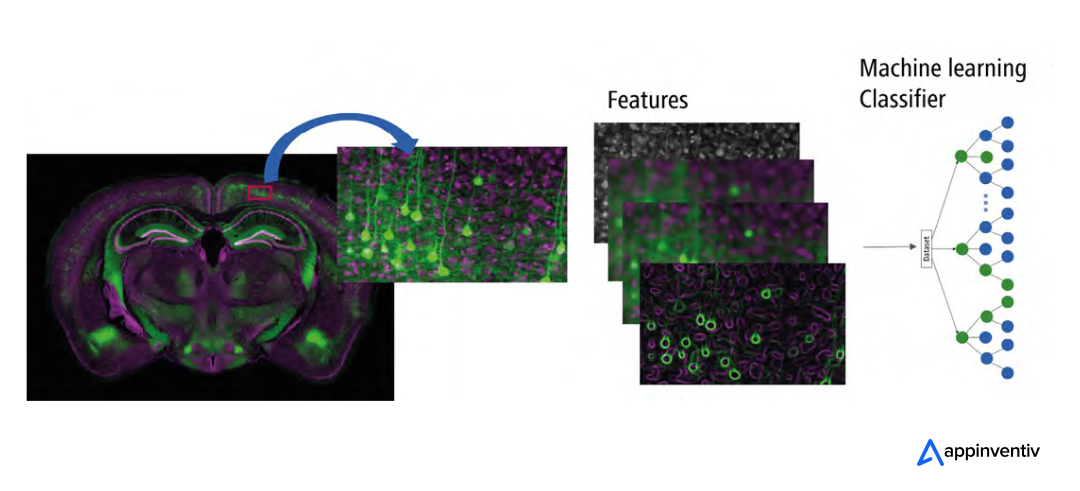
Automation of Routine Tasks
AI technology can automate many routine tasks in dentistry, such as updating patient records, managing appointments, or generating treatment reports. This reduces the administrative workload for dentists and their teams, allowing them to spend more time on patient care. Automation also reduces the risk of human error in data entry or scheduling, improving overall clinic operations and minimizing potential disruptions inpatient service.
Optimized Orthodontic Care
In orthodontics, AI-driven systems can analyze 3D dental scans to design optimal treatment plans for braces, aligners, and other orthodontic interventions. These tools can simulate the movement of teeth over time, helping orthodontists create more precise aligner trays or braces adjustments.
AI dentistry can predict how teeth will shift during treatment and suggest the best action, leading to shorter treatment durations and more effective patient outcomes.
Cost and Time Efficiency
By streamlining diagnostics, automating routine tasks, and optimizing treatment planning, AI dentistry significantly reduces time and costs in dental practices. Dentists can see more patients in less time and manage fewer manual processes.
Early diagnosis and predictive treatment can also prevent more costly, invasive procedures later. AI-driven dentistry leads to shorter appointment times and fewer patient visits, providing a more efficient and affordable dental care experience.
Predictive Analysis for Proactive Care
AI-driven predictive analysis harnesses historical patient data and real-time monitoring to forecast potential dental health issues before they escalate. This advanced approach enables dentists to design personalized preventive care plans and timely interventions, reducing the risk of complex procedures later on.
Increased Transparency and Trust
AI systems in dentistry are enhancing transparency by providing clear and data-backed insights into diagnostic processes and treatment outcomes. This helps in building patient confidence and also fosters stronger patient-provider relationships by clarifying the decision-making process.
Improved Data Analysis and Management
By leveraging AI for dentistry, practitioners can efficiently manage and analyze vast amounts of patient data, leading to more informed clinical decisions and optimized operational workflows. This comprehensive data management improves both patient care and practice efficiency by streamlining information retrieval and analysis.
Use Cases of AI In Dentistry
Let’s explore how AI in dentistry can empower dental practitioners to elevate their operations, boost productivity, and drive groundbreaking innovation through various use cases of AI in dentistry.
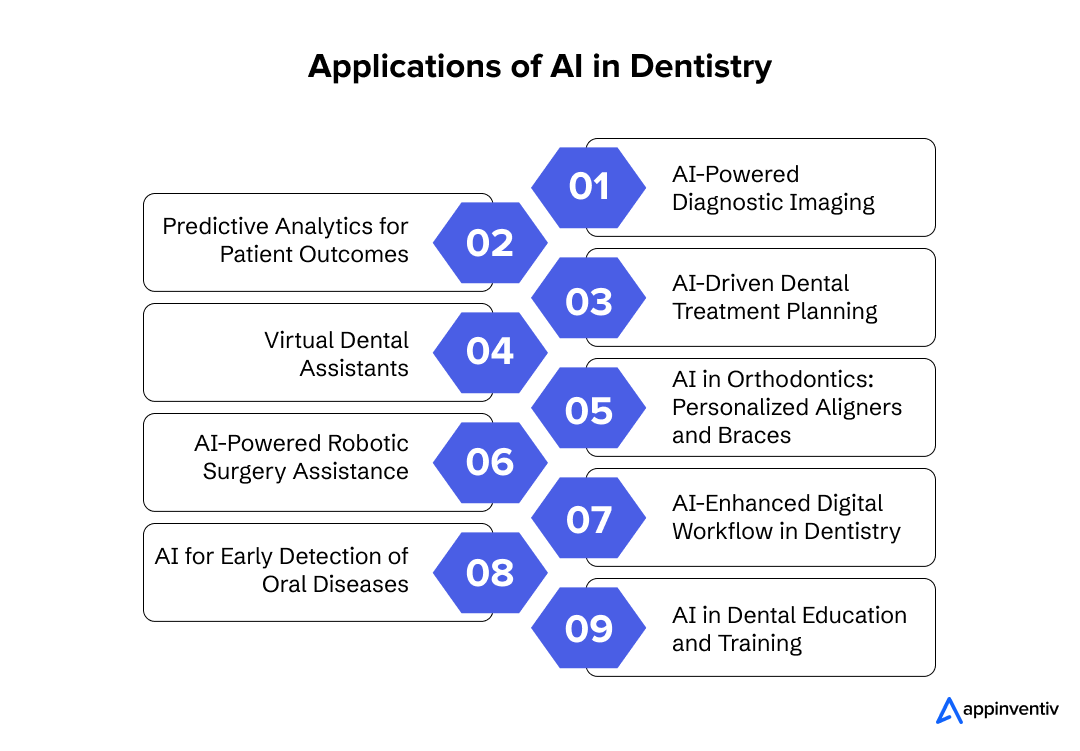
AI-Powered Diagnostic Imaging
AI-powered diagnostic imaging is transforming how dental professionals identify and treat conditions. Machine learning algorithms can accurately analyze X-rays, CT scans, and 3D images, detecting early signs of decay, periodontal disease, and even oral cancers.
By leveraging AI in dental care, dentists can spot abnormalities that might otherwise be missed by the human eye, thus improving the accuracy of diagnoses. This technology enhances interpretation speed, enabling quicker decision-making, which is particularly valuable in emergency dental care or complex surgical cases.
Over time, as AI continues to learn from a vast array of imaging data, its accuracy and ability to recognize intricate dental conditions will only improve.
Predictive Analytics for Patient Outcomes
AI’s ability to forecast patient outcomes is becoming a game-changer in personalized dental care. By analyzing historical data from similar cases, the AI dental app can predict how patients will respond to various treatments or surgeries, thus helping dentists make more informed decisions.
For example, it can suggest whether a patient will likely benefit from a specific orthodontic treatment based on the success rates of previous patients with similar oral structures and conditions.
Additionally, predictive analytics can help foresee potential complications, allowing dentists to take preventive measures well in advance, ensuring better patient outcomes and reducing the likelihood of treatment failure.
AI-Driven Dental Treatment Planning
Dental treatment planning is one of the major use cases of AI for dentistry. Now, creating a precise treatment plan tailored to a patient’s needs can be complex but AI-driven systems streamline this by smartly analyzing data from the patient’s oral health history, diagnostic images, and other relevant factors to design customized treatment plans.
These plans can include suggestions for tooth restoration, orthodontic treatments, or surgical interventions, all based on data from thousands of successful cases. Moreover, AI treatment planning can dynamically adjust the plan as new data becomes available, ensuring that the dentist always uses the most up-to-date and accurate information. This automation helps reduce the time spent on planning and increases the overall efficiency of dental practices.
Virtual Dental Assistants
AI-powered virtual dental assistants are invaluable in automating routine tasks, allowing dentists to focus on more complex clinical work. These assistants can schedule appointments, remind patients about follow-ups, and manage billing. More advanced systems can even assist dentists during procedures by providing real-time guidance based on diagnostic data, helping them decide on the most effective treatment approach.
Virtual assistants can also communicate directly with patients, answering common questions about treatments or post-care procedures. This improves the overall patient experience while reducing administrative burdens for dental staff.
AI in Orthodontics: Personalized Aligners and Braces
The role of AI in dentistry is revolutionizing orthodontics by providing more personalized solutions for tooth alignment. With the help of AI-powered 3D imaging and predictive algorithms, dentists and orthodontists can design custom-made aligners and braces that precisely match the patient’s dental structure.
Dental AI apps or software can simulate how the teeth will move over time with treatment and predict the outcome. This enhances the accuracy of aligner fitting, reduces treatment time, and minimizes patient discomfort.
Companies like Invisalign have already integrated AI into their production processes, offering a highly customized approach to orthodontic treatment that improves the efficiency and effectiveness of teeth straightening procedures.
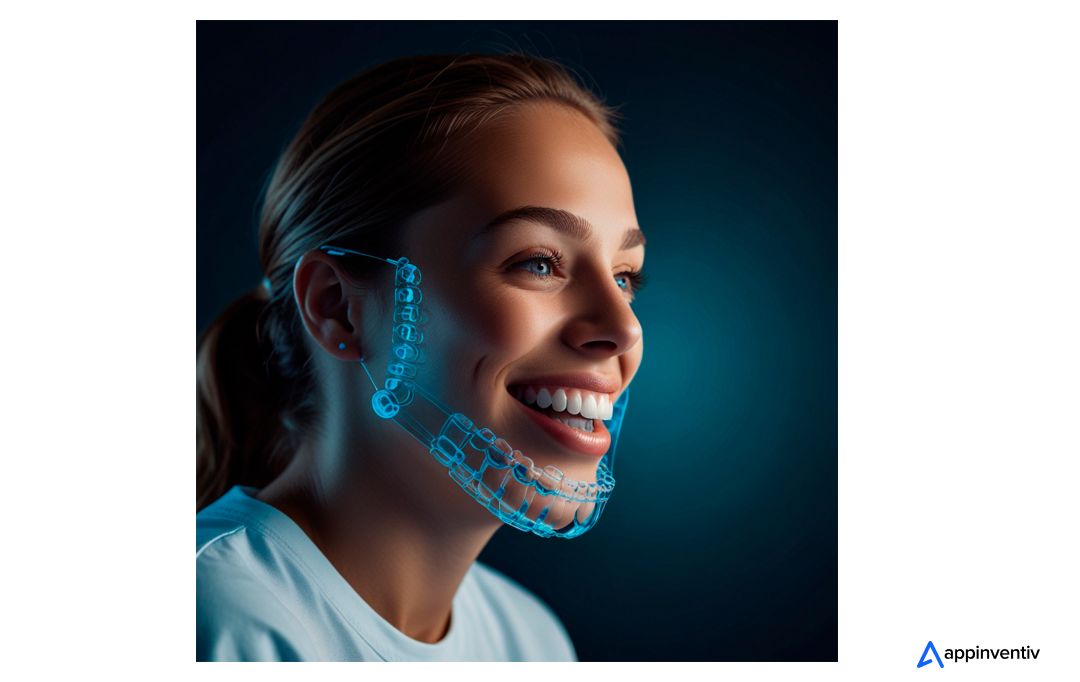
AI-Powered Robotic Surgery Assistance
AI-powered robots are increasingly assisting dentists with precision-based surgeries. With extreme accuracy, these systems can perform routine dental procedures like implant placements, bone grafting, and even complex extractions.
AI for dentistry robotics systems can map out the procedure in advance using patient data, guiding the dentist through the process or executing it semi-autonomously. This leads to reduced surgery times, lower risks of human error, and faster patient recovery times. Moreover, robotic systems can handle repetitive tasks, like drilling in implant surgeries, allowing dentists to focus on more critical decision-making aspects during surgery.
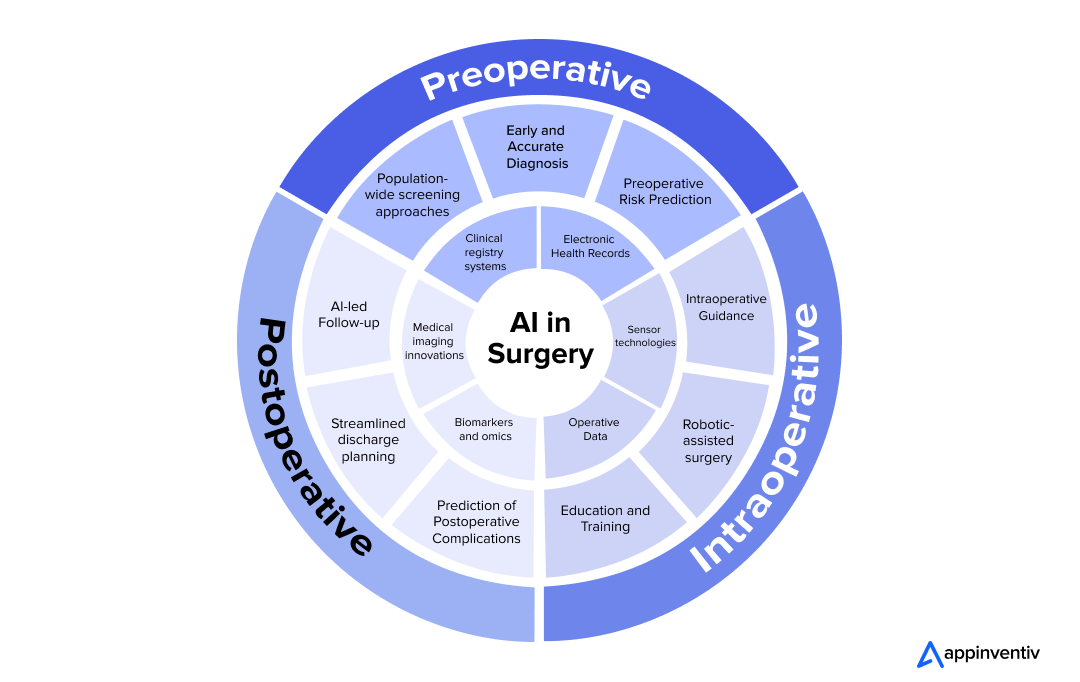
AI-Enhanced Digital Workflow in Dentistry
Integrating AI into digital workflows within dental practices is dramatically improving operational efficiency. AI can streamline patient record management, treatment planning, and billing tasks by automating processes that would otherwise require manual input.
In restorative dentistry, AI can design crowns, bridges, and veneers with a high degree of accuracy by analyzing patient data and matching it to the most suitable treatment options. This AI-enhanced workflow saves time and reduces the possibility of human error, improving clinical outcomes and patient satisfaction.
Practices that adopt AI-driven digital workflows are also seeing improvements in profitability as the technology reduces overhead costs associated with manual work.
AI for Early Detection of Oral Diseases
One of AI’s most significant benefits in dentistry is its ability to detect oral diseases at their earliest stages. Using machine learning models trained on vast datasets, AI systems can identify the tiniest signs of dental caries, gum disease, or oral cancer.
For example, dental AI tools can analyze saliva samples and scan for biomarkers that indicate early-stage cancer or inflammation long before symptoms become clinically visible. Early detection through AI allows for timely interventions, significantly improving treatment success rates. Dentists can rely on AI to provide alerts about potential issues before they manifest, enabling more proactive and preventive dental care.
AI in Dental Education and Training
AI is also shaping the future of dental education by providing simulation platforms for training aspiring dentists. Virtual reality (VR) simulations, powered by AI, offer dental students hands-on experience in diagnosing and treating conditions in a risk-free environment.
These systems can replicate real-life scenarios, allowing students to practice complex procedures without fearing harming a patient. AI can track the student’s performance, providing real-time feedback and suggesting improvements.
Furthermore, AI-driven systems can adapt training modules based on the student’s learning curve, ensuring personalized learning experiences that cater to individual strengths and weaknesses. This approach is accelerating the development of highly skilled dental professionals, improving the overall standard of dental care.
AI in Implantology
AI is making a significant impact on implantology by enhancing the precision of implant planning and placement. Advanced imaging and machine learning algorithms help in creating detailed 3D models of a patient’s oral anatomy. These models enable dental professionals to map out implant positions with extraordinary accuracy, minimizing the risk of complications.
Furthermore, predictive analytics assist in forecasting the healing and integration potential, ensuring personalized treatment planning and improved long-term outcomes.
AI in Dental Public Health
In dental public health, AI empowers professionals to analyze large datasets and monitor population-level oral health trends. Machine learning tools can identify patterns of dental diseases and help in the strategic planning of community health initiatives.
These insights pave the way for targeted public health campaigns and resource allocation, ensuring preventive measures reach the most vulnerable groups. AI also supports studies related to epidemics that improve overall community dental health by highlighting areas in need of intervention.
AI in Oral and Maxillofacial Surgery
Oral and maxillofacial surgery benefits highly from AI through improved surgical planning and execution. By integrating AI-powered diagnostic imaging with real-time data analysis, surgeons can simulate complex procedures before entering the operating room.
This increases the accuracy of surgeries like tumor resection and reconstructive operations and also reduces operation times and enhances patient safety. AI aids in pre-surgical planning by identifying critical anatomical structures and potential risks, ensuring precision during surgery.
Real-World Examples of AI in Dentistry
AI in dentistry is revolutionizing dental practices, improving accuracy, efficiency, and patient care. Here are a few real-world examples of AI applications in dentistry:
Pearl
Pearl is revolutionizing dental diagnostics with its AI platform, “Second Opinion.” This FDA-approved technology analyzes dental X-rays to detect various conditions, including cavities, bone loss, and gum disease. By leveraging advanced machine learning algorithms, Pearl enhances diagnostic accuracy, allowing dentists to identify issues at earlier stages.
This proactive approach improves patient outcomes and fosters a deeper understanding of patients’ oral health. With Pearl’s technology, dental professionals can provide more personalized care while reducing the risk of human error in interpreting radiographs.
Overjet
Overjet utilizes dental artificial intelligence to transform how dental professionals analyze radiographs and manage patient care. Overjet uses sophisticated AI algorithms to quantify disease progression and identify tooth decay and periodontal disease risks.
The platform’s predictive analytics capabilities enable dentists to intervene early, ensuring timely treatment for at-risk patients. Additionally, Overjet streamlines the documentation process for insurance claims by providing precise data analysis, thus enhancing the efficiency of dental practices. This dual approach optimizes dental operations while enhancing patient care.
Dentem
Dentem harnesses the power of artificial intelligence in dentistry to improve diagnostic capabilities in dentistry. By analyzing dental X-rays and scans, Dentem’s AI algorithms detect conditions such as cavities, gum disease, and other oral health issues with remarkable accuracy.
This AI technology in dentistry aids dental professionals in making informed treatment decisions, ensuring patients receive tailored care based on their unique needs.
By minimizing the risk of human error in diagnostics, Dentem enhances the overall quality of care and empowers dental practices to focus on providing exceptional patient experiences. Integrating AI into their workflow positions Dentem as a key player in the evolution of modern dentistry.
Transforming Dental Practices: A Guide to Implementing AI Solutions
Here are compelling real-world examples of AI in dentistry, showcasing the remarkable success achieved by various organizations.
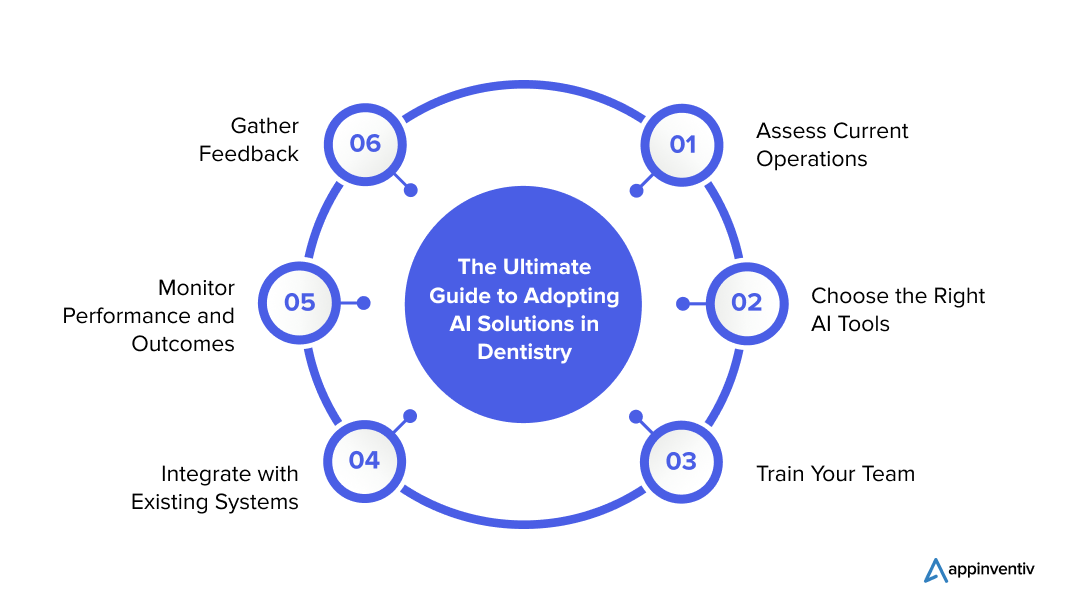
Assess Current Operations
Before implementing artificial intelligence in dentistry, it’s essential to conduct a thorough assessment of your current operations. This involves evaluating your workflows to identify areas where artificial intelligence in dentistry can add value.
Focus on repetitive tasks that consume time, such as appointment scheduling, billing, and data management practices for patient information. By understanding where inefficiencies lie, you can pinpoint opportunities for automation and improvement, ensuring that the AI solutions you choose will effectively address your practice’s specific needs.
Choose the Right AI Tools
Once you clearly understand your operations, the next step is to research and select the appropriate AI tools tailored to your practice’s needs. Consider solutions for imaging analysis that can assist in diagnosing conditions more accurately, as well as patient management systems that streamline appointment scheduling and reminders.
Additionally, explore AI applications like chatbots and virtual assistants that enhance patient communication. By aligning your tool selection with the identified operational gaps, you can maximize the impact of AI in dentistry.
Train Your Team
Successful implementation of solutions powered by Artificial Intelligence in dentistry hinges on your team’s ability to adapt to new AI technology in dentistry. Therefore, investing in comprehensive training sessions for your staff is crucial. These sessions should cover how to effectively use the selected AI tools and familiarize your team with any workflow changes.
Providing ongoing support is equally important; establish a system where team members can ask questions and seek assistance as they become accustomed to the new technology. This approach ensures that everyone is confident in utilizing AI to its full potential.
Integrate with Existing Systems
To avoid disruption during the transition, focus on seamlessly integrating AI tools with your current dental software and systems. Conduct compatibility checks to ensure the selected AI solutions can effectively work with your existing infrastructure.
Consider a phased integration approach, allowing you to implement AI tools gradually. This strategy minimizes operational interruptions and will enable you to make adjustments based on initial feedback from your team.
Monitor Performance and Outcomes
After implementing AI solutions, monitoring their performance and outcomes is crucial. Establish key performance indicators (KPIs) to measure the effectiveness of the tools, focusing on metrics such as diagnostic accuracy, operational efficiency, and patient satisfaction.
Regularly evaluate how well the AI solutions meet your practice’s goals. This ongoing monitoring allows you to make informed decisions about any necessary adjustments, ensuring that the AI technology in dentistry continues to deliver value over time.
Gather Feedback
Gathering feedback from both staff and patients is vital for continuously improving your artificial intelligence in dentistry solutions. Create dedicated channels for team members and patients to share their experiences and suggestions regarding the new tools.
Analyzing this feedback will provide valuable insights into what works well and may need adjustment. By actively engaging with your staff and patients, you can foster an environment of collaboration and improvement, ensuring that the AI solutions evolve to meet the needs of your practice and enhance the patient experience.

Challenges of AI in Dentistry: Overcoming Obstacles for Effective Integration
While adopting artificial intelligence in dentistry presents numerous opportunities, it also brings certain challenges of artificial intelligence in dentistry. Let’s explore artificial intelligence dentistry challenges and their potential solutions.
Challenge: Data Quality and Quantity
AI systems need large, high-quality datasets for accurate training and performance, but the dental industry lacks sufficient, well-annotated data, making AI applications less effective.
Solution:
To overcome this, dental practitioners can collaborate with research institutions and tech companies to create comprehensive, anonymized dental datasets. These partnerships help aggregate diverse data, improving AI’s learning potential.
Additionally, synthetic data generation techniques can expand existing datasets, allowing AI to work with a broader range of dental scenarios. This demonstrates the prominent role of AI in dentistry.
Challenge: Regulatory Compliance
AI technologies must comply with strict health regulations like HIPAA or GDPR, which can be challenging due to the sensitive nature of dental and medical data.
Solution:
Working closely with legal experts and regulatory authorities is essential. Developers should ensure their AI systems comply with health data protection laws. Data encryption, transparent algorithms, and frequent audits will help meet regulatory requirements while maintaining patient trust and privacy.
Challenge: Integration with Existing Systems
Many dental practices still use legacy systems, making it difficult to integrate AI-driven technologies seamlessly.
Solution:
To solve this issue, AI developers can focus on creating interoperable systems with open APIs, ensuring they easily integrate with existing practice management software. This allows dental professionals to incorporate AI dental software without overhauling their current infrastructure, reducing costs and complexity.
Challenge: High Implementation Costs
Adopting AI can be expensive, especially for smaller practices, due to the cost of software, hardware, and staff training.
Solution:
Offering scalable, cloud-based AI solutions can reduce upfront costs by allowing practices to pay based on usage. Vendors can also provide tiered pricing options, helping dental practices start small and expand as needed. Financial incentives or grants from professional dental organizations or governments can further help reduce implementation barriers.
Challenge: Clinical Validation
Insufficient clinical trials validate AI’s effectiveness in dental applications, which makes practitioners skeptical about its reliability.
Solution:
Conducting thorough clinical trials and pilot programs in collaboration with dental professionals can ensure the effectiveness of AI in dental care. AI vendors can build trust with the dental community by proving their value in real-world settings. Feedback from these trials can also refine AI algorithms for more accurate and reliable results.
Ethical Considerations of AI in Dentistry
As AI continues to revolutionize dental care, it is vital to address the ethical implications of its use. Ensuring that AI technology is implemented responsibly helps safeguard patient rights, maintains trust, and promotes fairness throughout dental practices.
Patient Privacy and Data Security
Protecting sensitive patient information is crucial when using AI systems. Dental practices must ensure that all data collected, stored, and processed is securely encrypted and accessed only by authorized personnel.
Transparency in AI Decision-Making
Patients have the right to understand how AI assists in their diagnosis and treatment planning. Clear communication about AI’s role in decision-making builds trust and empowers patients to make informed decisions about their care.
Algorithmic Fairness
It is important that AI systems provide unbiased assessments. This requires the use of diverse data in training algorithms and regular audits to ensure that decisions are equitable for all patients, regardless of their background.
Informed Consent
Patients should be fully informed about how AI technology is used in their dental care. This includes explaining the benefits and potential risks so that they can consent to AI-supported procedures with complete understanding.
Human Oversight
Even as AI enhances diagnostic and treatment planning capabilities, human expertise remains essential. Dentists should always review AI recommendations to ensure that ethical standards and clinical judgment are maintained throughout the treatment process.
Emerging AI Trends Shaping the Future of Dentistry
Emerging AI trends in dentistry are reshaping the landscape with advanced technologies that enhance diagnostics, treatment planning, patient care, and operational efficiency. Here’s a detailed look at key innovations that will significantly revolutionize the artificial intelligence in dentistry ecosystem:
AI-Powered Diagnostic Imaging
AI dental app algorithms are increasingly integrated into dental imaging systems to provide more accurate diagnostics. By leveraging deep learning, AI dental diagnosis can analyze X-rays, CT scans, and intraoral images to detect dental issues such as cavities, periodontal diseases, and even early-stage oral cancers with higher precision.
Future advancements will see AI systems autonomously identifying abnormalities and assisting dentists in interpreting complex images, reducing human error.
- Convolutional Neural Networks (CNNs): Used for image classification, segmentation, and pattern recognition in dental radiographs, improving diagnostic accuracy.
- 3D Imaging and AI: AI dental software will drive the development of more sophisticated 3D imaging tools, enabling detailed visualization of tooth and bone structures to facilitate complex procedures like implant placement and orthodontics.
Robotic-Assisted Dental Surgery
AI-driven robotics are emerging in dental surgeries, particularly for tasks requiring extreme precision, such as implant placement and tooth extractions. These systems, powered by dental artificial intelligence algorithms, allow minimal invasiveness, shorter recovery periods, and greater accuracy.
- AI-Guided Robotic Arms: Autonomous robotic systems will work alongside human dentists, performing repetitive or intricate tasks like drilling enhancing the precision of procedures.
- AI-Enhanced Augmented Reality (AR): In the future, robotic-assisted surgeries could be combined with AR systems, overlaying real-time data and guidance for dentists, further reducing the chance of error in artificial intelligence in dentistry.
AI for Real-Time Risk Assessments and Preventive Care
In preventive dentistry, AI dental software is being developed to monitor a patient’s oral health continuously in real-time. Smart toothbrushes and wearables powered by AI will analyze brushing habits, detect early signs of disease, and alert patients and dentists to potential problems before they become severe.
- Wearable AI Sensors: These sensors will detect changes in saliva composition, temperature, or inflammation, providing real-time data to prevent dental emergencies. This demonstrates the prominent role of AI in dentistry.
- AI-Powered Oral Health Platforms: Future platforms will combine IoT with AI to deliver a comprehensive view of a patient’s dental health, offering predictive analysis for patients and practitioners.
AI-Powered Teledentistry
AI-driven teledentistry is poised to revolutionize remote dental care by facilitating virtual consultations and diagnostics. Advanced AI algorithms can analyze patient data from remote monitoring devices, enabling dentists to deliver timely and accurate assessments without geographical constraints.
- Virtual Consultations: Real-time data analysis during remote appointments helps in diagnosing issues and recommending care, improving access for underserved populations.
Customized Treatment Planning
AI in dentistry will enable highly personalized treatment plans by integrating digital imaging, patient history, and predictive analytics. This approach allows dental professionals to design interventions tailored to the unique needs of each patient, improving clinical outcomes and satisfaction.
- Personalized Protocols: Customized treatment strategies not only target specific dental issues more effectively but also enhance overall procedural success rates.
Big Data Insights in Dentistry
Big data analytics powered by AI will allow dental practitioners to harness vast amounts of patient data to identify patterns and predict future trends. These insights will support evidence-based decision-making, leading to improved treatment strategies and higher success rates.
- Data-Driven Decisions: Analyzing large datasets helps refine treatment protocols and identify emerging dental health trends to enhance overall care.
Enhanced Patient Engagement
AI tools will drive a new era of patient engagement by offering personalized communication, appointment reminders, and interactive care management. By providing custom-tailored information, these technologies will help patients take a more proactive role in their dental health.
- Interactive Platforms: Enhanced digital interfaces facilitate ongoing communication between patients and dental professionals, fostering loyalty and ensuring better adherence to treatment plans.
How Appinventiv Can Help You in Developing AI for Your Business
Appinventiv is a leading AI development company that empowers businesses to unlock the full potential of artificial intelligence. We offer comprehensive support, starting with strategic planning and in-depth research to identify the best AI solutions for your goals. With a team of 1600+ highly skilled experts, we ensure cutting-edge AI integration across various industries, using the latest advancements in machine learning, natural language processing, and computer vision.
Why Appinventiv is the best choice for AI development:
- Scalable AI Solution: Appinventiv delivers customized, scalable AI solutions tailored to meet your business objectives, ensuring optimal results.
- Agile Development Approach: Our agile development approach guarantees fast and efficient delivery of projects without compromising on quality.
- Security & Privacy: We prioritize security, data privacy, and seamless integration with your existing systems, ensuring a smooth and secure transition to AI.
- Expertise: Appinventiv has a proven track record with global clients across diverse industries, showcasing our ability to drive innovation and optimize operations.
- Tech Know-how: We leverage the latest advancements in machine learning, natural language processing, and computer vision to provide cutting-edge AI solutions.
- Automation: Our solutions help businesses automate processes, enhance decision-making, and improve customer experiences effectively.
Partner with us to harness the transformative power of AI and dentistry for your business and drive outstanding results through advanced innovation.
FAQs
Q. What are the advantages of AI in dentistry?
A. AI offers numerous advantages in dentistry, such as improving diagnostic accuracy, streamlining administrative tasks, personalizing treatment plans, and enhancing patient outcomes. AI also enables real-time data analysis for early disease detection and assists dentists in decision-making.
Q. What is the process of implementing AI in dentistry?
A. Implementing AI in dentistry involves several steps: identifying the areas of dental practice that can benefit from AI, selecting appropriate AI tools and software, training staff, integrating AI systems with existing AI technology in dentistry, and continuously monitoring performance for improvements.
Q. What does the future of AI in dentistry look like?
A. The future of AI in dentistry is promising, with potential advancements in automated diagnostics, personalized treatment planning, robotic-assisted surgeries, and AI-powered virtual consultations. AI is expected to further revolutionize patient care by reducing human error and improving efficiency.
Q. How is AI transforming dentistry today?
A. AI is transforming dentistry by automating routine tasks like scheduling, billing, and record-keeping, while assisting in clinical decision-making. AI tools enhance image analysis for more accurate diagnostics, predict treatment outcomes, and personalize patient care through data-driven insights.
Product Development & Engineering
IT Managed & Outsourcing
Consulting Services
Data Services
Didn't find what you're looking for? Let us know your needs, and we'll tailor a solution just for you.



